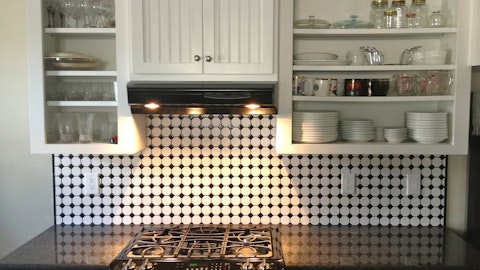Scott Culbreth: Steven, I’m not tracking your question. So the outlook that we’re going to give for the full year does include everything that we’ve achieved through the first nine months of the year. And we’re trying to give you a range of exactly where it’s going to be within that last quarter.
Steven Ramsey: Got you. Yes. I just wanted to make sure is there — for the raised EBITDA outlook, is that mostly attributable to year-to-date results, or is there — is Q4 shaping up better than what you thought from the prior outlook?
Scott Culbreth: Yes, I’d say it’s a combination of both is throughout the year, we’re performing a lot better. So in essence, gives us the confidence to raise our outlook for the full year.
Steven Ramsey: Okay. Great. Thank you.
Operator: Our next question comes from Tim Wojs from Baird. Please go ahead with your question.
Tim Wojs: Hey, guys. Good afternoon. Maybe just to start Scott on the new — the 1951 brand. Could you just maybe give us a little bit of color of kind of where — you know, kind of the market strategy behind the introduction of the new brand and then maybe kind of what your three- to five-year targets might be for, you know, growth related to that business?
Scott Culbreth: Hey, good afternoon, Tim. So, yes, 1951, you know, prior to us launching that brand, our strategy when we thought about the New Construction market was to serve it with one brand, and that brand was Timberlake. And that was regardless of how that particular builder wanted to really go about obtaining their cabinetry product. So what we’ve done now with 1951 is we’ve been able to consolidate, you know, all of our various platforms that we’ve got underneath the Woodmark umbrella. We’re able to now provide to principally distributors, but also to some dealers, a brand that will be specifically focused on their business requirements. We want to make sure we give a choice to, you know, whether it’s a builder, a contractor, a remodeler, the right product, and the right service model that they want to actually utilize.
So, we’re excited about it. The actual go-live is March 4. So, you know, we’re a week before, but it’ll be live March 4. It’s already up on the website and available. And our commercial team is already out preselling and talking obviously to our distributors. So, we think it’ll be a great opportunity to perhaps take away from some potential channel conflict that’s existed in the past and gives us an opportunity to drive more growth in that channel. As far as specific goals, I don’t have a goal that I want to put out in the market today specific to that. I’ll just tell you that’s part of the strategy and the overall outlook that we shared in our investor relation deck. We did a refresh on that back in January and posted that on the website. So that’s factored into that financial model.
Tim Wojs: Okay. Okay. Very good. Maybe just on the startup cost, the $8 million to $9 million this year. I know you’re kind of, you know, some of your — you don’t want to talk too much about next year. But is there any kind of startup cost tail we should kind of think about that leads into next year or the first half of next year?
Scott Culbreth: It’s not necessarily a startup cost tail. So I would say that the startup costs go away, right? That’s a lot of the costs we had prior to being ready for production and ramping. It’ll now shift to being deleveraged. So we’ll have some fixed costs associated with those facilities. If we’re not fully utilizing absorbing those, there’ll be some, you know, deleverage that would roll through the results there. But you’re right, we haven’t modeled that fully out yet to give you a look, but we won’t have this ramp cost to get ready like we had in fiscal year ’24.
Tim Wojs: Okay. Okay. And then the last one for me just on mix. You know, there’s been some other kind of building product industries and categories that have talked about, you know, some negative mix, you know, kind of impacting whether it’s, you know, consumer trade down in the R&R market or maybe it’s smaller homes in new construction. Are you guys seeing that? Or is it a situation where your portfolio is kind of built around, you know, some of those mixed changes, and it’s actually a benefit to American Woodmark in terms of just how the markets evolved?
Scott Culbreth: Yes. You got it, Tim. It’s the latter part. When you think about our portfolio and the price points that we go after. You know, we’re not sitting in the semi-customer custom range, where you might see folks move down in our category or even other categories of building products. So we go after the value price point offering. That’s where we’ve been focused as a company for decades and that’s where the market is shifting. So we’re not dealing with a rotation down at higher price points. We’re already at the value price points. And as shared earlier in the call, we really haven’t seen much rotation, even inside our portfolio down.
Tim Wojs: Okay. Okay. Very good. Good luck on the rest of the year. Thank you.
Paul Joachimczyk: Yes. Thanks, Tim.
Scott Culbreth: Thanks, Tim.
Operator: [Operator Instructions] Our next question comes from Collin Verron with Jefferies. Please go ahead with your question.
Collin Verron: Good afternoon. Thanks for taking my questions. I guess I just wanted to start on the R&R market. It looks like it’ll probably be like a second-half story in calendar year ’24, just based on commentary from other building product manufacturers and the sentiment at the builder show this week. But I was curious if you had any thoughts on what needs to happen for the R&R market to really come back, whether that’d be a certain mortgage rate level or some other factor. And just how quickly you think demand can snap back when that happens.
Scott Culbreth: Yes. I’ll take the latter part first on the equation. So how fast it comes back? I’m not sure. We talk a lot internally about, it’ll come, it’ll come quicker than we probably are anticipating. We just want to make sure we’re ready for it. We believe there’s some pent-up demand there and when consumers get comfortable again, they’re going to come back in a pretty meaningful fashion and want to do projects. We do think about the second half being stronger. What are the things that we’re going to keep focused on that we think will help drive that. Interest rates are going to be at the top of the list whatsoever really going to happen? I know we’ve pushed out a march potential reduction to now, June. Even then I think it’s a 60% somewhat estimate on actually bringing it down 25 basis points.





